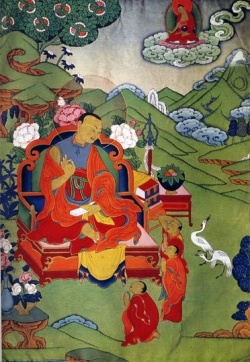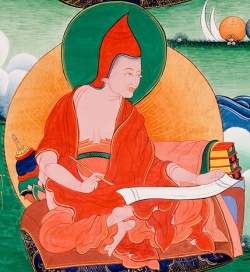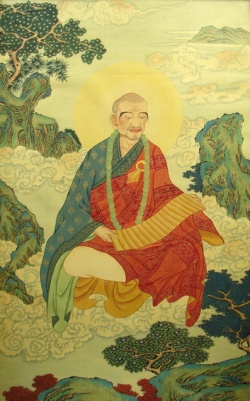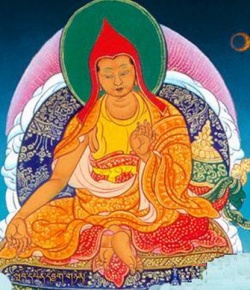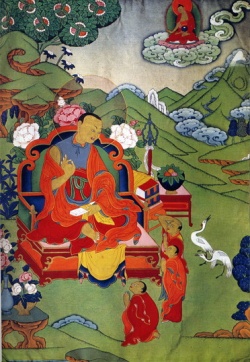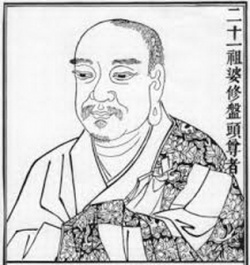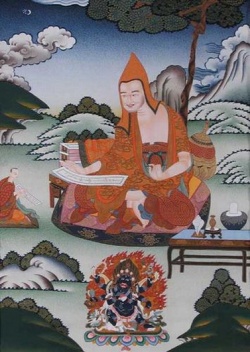Yogācāra (Sanskrit: ''yoga practice''
Yogācāra (Sanskrit: "yoga practice"; "one whose practice is yoga" is an influential school of Buddhist philosophy and psychology emphasizing phenomenology and (some argue) ontology through the interior lens of meditative and yogic practices. It developed within Indian Mahāyāna Buddhism circa the fourth century C.E. Yogacara discourse is founded on the existential truth of the human condition: there is nothing that humans experience that is not mediated by mind.
History
The Yogācāra is, along with the Madhyamaka, one of the two principal schools of Indian Mahayana Buddhism.
Origination
Masaaki (2005) states that: "[a]ccording to the Saṃdhinirmocana sūtra the first Yogācāra text, Buddha set the "wheel of the doctrine" (dharmacakra) in motion three times." Hence, the Saṃdhinirmocana sūtra, as the doctrinal trailblazer of Yogācāra, inaugurated the endemic categorical triune of the The Three Turnings of the Wheel of Dharma; establishing its tenets among the exegesis of the Dharmacakra's "Third Turning". The Yogācāra texts are generally considered part of the Third Turning along with the relevant sūtra. Moreover, Yogācāra discourse surveys and syncretically redacts all Three Turnings. The origins of the scholarly Indian Yogācāra tradition were rooted in the syncretic scholasticism of Nālandā University where the doctrine of Cittamātra was first extensively propagated. Doctrines, tenets and derivatives of this school have influenced and become well-established in China, Tibet, Japan and Mongolia and throughout the World via the dissemination and dialogue wrought by the Buddhist diaspora. Yogācāra, like all Indian schools of Buddhism, eventually became virtually extinct within India.
Vasubandhu, Asanga and Maitreya-natha
Yogācāra, which had its genesis in the aforementioned sutra, was largely formulated by the brahmin born half-brothers Vasubandhu and Asanga (who was said to be inspired by the quasi-historical Maitreya-nātha or the divine Maitreya). Lineage and traditions of sadhana and Dharma transmission is primary and key to Buddhism. This school held a prominent position in the Indian scholastic tradition for several centuries due to its lauded pedigree and propagation at Nālandā.
Yogācāra and Mādhyamaka
Notably, this school was in protracted dialectic (as different from opposition) with the Mādhyamaka. In short (and though rather simplistic and not entirely true), while the Mādhyamaka held that asserting the existence or non-existence of any ultimately real thing was inappropriate, some exponents of Yogācāra asserted that the mind (or in the more sophisticated variations, primordial wisdom) and only the mind is ultimately real. Not all Yogācārins asserted that mind was truly existent, according to some interpretations Vasubandhu and Asaṅga in particular did not. Later Yogācāra views synthesized the two, in particular Shantarakshita whose view is attributed as Yogacara-Svatantrika-Madhyamika. In his view the Mādhyamika position is ultimately true and at the same time the mind-only view is a useful way to relate to conventionalities and progress students more skillfully toward the ultimate. This synthesized view between the two positions — which also incorporated views of valid cognition from Dignaga and Dharmakirti — was one of the last developments of Indian Buddhism before it was extinguished in the eleventh century during the Muslim incursion. This view was also expounded by Xuanzang, who after a suite of debates with exponents of the Madhyamaka School, composed in Sanskrit, the no longer extant three-thousand verse treatise on "The Non-difference of Madhyamaka and Yogācāra". Later Yogācāra teachings are especially important in Tantric Buddhism, which evolved within their development in India.
Yogācāra in Tibet
Yogācāra was transmitted to Tibet by Shantarakṣita and later by Atiśa; it was thereafter integral to Tibetan Buddhism although the prevailing Geluk-dominated view held that it was less definitive than Madhyamaka. Yogācāra is primary to the Nyingmapa and its zenith, Dzogchen. Yogācāra also became central to East Asian Buddhism. The teachings of Yogācāra became the Chinese Wei Shih school of Buddhism. Current debates among Tibetan schools between the Shentong (empty of other) versus Rangtong (empty of self) views appear similar to earlier debates between Yogācāra and Mādhyamika but the issues and distinctions have evolved further. Though the later Tibetan views could be said to have evolved from the earlier Indian positions, the distinctions between the views became increasingly subtle especially once Yogācāra incorporated the Mādhyamika view of the ultimate. In the 19th century rime movement commenter Ju Mipham — in his commentary on Shantarakshita's synthesis — wrote that the ultimate view by both schools is the same and the result of each path also leads to the same ultimate state of abiding.
Divergence of the Yogācāra of India and China
By the closure of the Sui Dynasty (589-618), Buddhism within China had developed many distinct schools and traditions. Xuanzang, in the words of Dan Lusthaus:
...came to the conclusion that the many disputes and interpretational conflicts permeating Chinese Buddhism were the result of the unavailability of crucial texts in Chinese translation. In particular, he [[[Xuanzang]]] thought that a complete version of the Yogācārabhūmi-śāstra, an encyclopedic description of the stages of the Yogācāra path to Buddhahood written by Asaṅga, would resolve all the conflicts. In the sixth century an Indian missionary named Paramārtha (another major translator) had made a partial translation of it. Xuanzang resolved to procure the full text in India and introduce it to China.
Moreover, Dan Lusthaus charts the different dialectic and divergent traditions of Buddhism within India and China discovered by Xuanzang and mentions the Buddha-nature, Awakening of Faith, Tathāgata-garbha:
Xuanzang also discovered that the intellectual context in which Buddhists disputed and interpreted texts was much vaster and more varied than the Chinese materials had indicated: Buddhist positions were forged in earnest debate with a range of Buddhist and non-Buddhist doctrines unknown in China, and the terminology of these debates drew their significance and connotations from this rich context. While in China Yogācāra thought and Tathāgata-garbha thought were becoming inseparable, in India orthodox Yogācāra seemed to ignore if not outright reject Tathāgata-garbha thought. Many of the pivotal notions in Chinese Buddhism (e.g., Buddha-nature) and their cardinal texts (e.g., The Awakening of Faith) were completely unknown in India.
Principal exponents of Yogācāra
Principal exponents of Yogācāra categorized and alphabetized according to location:
China: Xuanzang and Kuiji (K'uei-chi);
India: the half-brothers Asanga and Vasubandhu; Sthiramati and Dharmapala
Japan: Chitsū and Chidatsu (NB: both these people are mentioned in Kusha (Buddhism))
Korea: Daehyeon, Sinhaeng (704-779), Weonchuk (631-696) and Weonhyo (617 - 686); and
Tibet: Dolpopa, Taranatha, Jamgon Kongtrul Lodro Thaye, Ju Mipham
Yogācāra textual corpus
The Saṃdhinirmocana sūtra ("Unravelling the Mystery of Thought Sutra, 2nd Century CE) was the seminal Yogācāra sutra, which continued to be a primary referent for the tradition. Also containing Yogācāra elements were the Pratyutpanna Sutra (1st Century CE) and Daśabhūmika Sutra (pre-3rd century CE).. The later Lankāvatāra Sutra ("Descent into Lanka Sutra", 4th century CE) also assumed considerable importance.
Five treatises of Maitreya
Among the most important texts to the Yogācāra tradition to be the "Five Treatises of Maitreya." These texts are said to have been related to Asaṅga by the Buddha Maitreya. They are as follows:
Ornament for Clear Realization (Abhisamayalankara, Tib. mngon par rtogs pa'i rgyan)
Ornament for the Mahayana Sutras (Mahayanasutralankara, Tib. theg pa chen po'i mdo sde'i rgyan)
Sublime Continuum of the Mahayana (Mahayanottaratantrashastra, Uttara-tantra-shastra, Ratnagotravibhaga, Tib. theg pa chen po rgyud bla ma'i bstan)
Distinguishing Phenomena and Pure Being (Dharmadharmatavibhanga, Tib. chos dang chos nyid rnam par 'byed pa)
Distinguishing the Middle and the Extremes (Madhyantavibhanga, Tib. dbus dang mtha' rnam par 'byed pa)
A commentary on the Ornament for Clear Realization called Clarifying the Meaning by the Indian scholar Haribhadra is often used, as is one by Vimuktisena. Most of these texts were also incorporated into the Chinese tradition, which was established several centuries earlier than the Tibetan. However, the Ornament for Clear Realization (Abhisamayalankara), is not mentioned by Chinese translators up to the 7th Century, including Xuanzang, who was an expert in this field, which suggests it may possibly have emerged from a later period than is generally ascribed.
Other texts
Vasubandhu wrote three foundational texts of the Yogācāra, the "Treatise on the Three Natures" (Sanskrit: Trisvabhāva-nirdeśa, Tib. Rang bzin gsum nges par bstan), the "Treatise in Twenty Stanzas" (S: Vimsatikā-kārikā) and the "Treatise in Thirty Stanzas" (S: Trimsikaikā-kārikā). He also wrote an important commentary on the Madhyantavibhanga. According to Buddhist scholar Jay Garfield:
While the Trisvabhāva-nirdeśa is arguably the most philosophically detailed and comprehensive of the three short works on this topic composed by Vasubandu, as well as the clearest, it is almost never read or taught in contemporary traditional cultures or centers of learning. The reason may be simply that this is the only one of Vasubandhu’s root texts for which no autocommmentary exists. For this reason, none of Vasubandhu’s students composed commentaries on the text and hence there is no recognized lineage of transmission for the text. So nobody within the Tibetan tradition (the only extant Mahayana scholarly tradition) could consider him or herself authorized to teach the text. It is therefore simply not studied, a great pity. It is a beautiful and deep philosophical essay and an unparalleled introduction to the Cittamatra system.
Authorship of critical Yogācāra texts is also ascribed to Asanga personally (in contrast to the Five Treatises of Maitreya). Among them are the Mahāyāna-samgraha adn the Abhidharma-samuccaya. He is sometimes ascribed authorship of the Yogācārabhūmi Śāstra, a massive encyclopedic work considered the definitive statement of Yogācāra, but most scholars believe it was compiled in the 5th century CE. Other important commentaries on various Yogācāra texts were written by Sthiramati (6th century CE) and Dharmapala (7th century CE), and an influential Yogācāra-Madyhamika synthesis was formulated by Śāntarakṣita (8th century).
Yogācāra Tenets
Muller (2005) charts two principal points of entry into the tenets of Yogācāra soteriology: the first, employs an admixture of the 'eight consciousnesses' (Sanskrit: Aṣṭa Vijñāna), 'four parts of cognition', 'three natures', and the 'doctrine of selflessness', etc.; the second, embraces the 'two hindrances' (Sanskrit: dve āvaraṇe; Tibetan: sgrib pa gñis). Muller (2005) furthermore states that:
There is no special need to try to assess whether one of these approaches is better than the other, for indeed, in the vast and complex system that is known as Yogācāra, all of these different approaches and categories are ultimately tied into each other, and thus, starting with any one of them, one can eventually enter into all of the rest.
Hattori Masaaki (2005) states that Yogācāra:
...attaches importance to the religious practice of yoga as a means for attaining final emancipation from the bondage of the phenomenal world. The stages of yoga are systematically set forth in the treatises associated with this tradition.
Keenan, et al. (2003) states that:
...the Yogācāra thinkers did not simply comment on Mādhyamika thought. They attempted to ground insight into emptiness in a critical understanding of the mind, articulated in a sophisticated theoretical discourse.
Yogacarins developed an Abhidharma literature set within a Mahayana framework.
Consciousness-only
One of the main features of Yogācāra philosophy is cittamātra, or consciousness only. That term was used in Tibet interchangably with Yogācāra, although modern scholars believe this is misleading.
The Three Natures
The Yogācāra defined three basic modes by which we perceive our world. These are referred to in Yogācāra as the three natures of perception. They are:
Parikalpita, literally "fully conceptualized", or Imaginary Nature, wherein things are incorrectly apprehended based on conceptual construction, through attachment and erroneous discrimination.
Paratantra, literally "other dependent", or Dependent Nature, by which the correct understanding of the dependently originated nature of things is understood.
Parinispanna, literally "fully accomplished", or Absolute Nature, through which one apprehends things as they are in themselves, uninfluenced by any conceptualization at all.
Also, regarding perception, the Yogācāra emphasized that our everyday understanding of the existence of external objects is problematic, since in order to perceive any object (and thus, for all practical purposes for the object to "exist"), there must be a sensory organ as well as a correlative type of consciousness to allow the process of cognition to occur.
Eight Consciousnesses
Perhaps the best known teaching of the Yogācāra system is that of the eight layers of consciousness (Sanskrit: Aṣṭa Vijñāna). This theory of the consciousnesses attempted to explain all the phenomena of cyclic existence, including how rebirth occurs and precisely how karma functions on an individual basis. For example, if I carry out a good or evil act, why and how is it that the effects of that act do not appear immediately? If they do not appear immediately, where is this karma waiting for its opportunity to play out? The answer given by the Yogācāra was the store consciousness (also known as the base, or eighth consciousness; Sanskrit: 'ālayavijñāna') which simultaneously acts as a storage place for karma and as a fertile matrix that brings karma to a state of fruition. It may be ultimately traceable to the "luminous mind" of the agamas. The likeness of this process to the cultivation of plants led to the creation of the metaphor of seeds (Sanskrit, bijas) to explain the way karma is stored in the eighth consciousness. The type, quantity, quality and strength of the seeds determine where and how a sentient being will be reborn: one's species, sex, social status, proclivities, bodily appearance and so forth. On the other hand, the karmic energies created in the current lifetime through repeated patterns of behavior are called habit energies (Sanskrit: vasana). All the activities that mold our bodymind, for better or worse--eating, drinking, talking, studying, practicing the piano or whatever--can be understood to create habit energies. And of course, my habit energies can penetrate the consciousnesses of others, and vice versa--what we call "influence" in everyday language. Habit energies can become seeds, and seeds can produce new habit energies.
Śūnyatā in Yogācāra
The doctrine of emptiness (Skt. Śūnyatā) is central to Yogācāra, as to any Mahayana school. Early Yogācāra texts, such as the Yogacarabhumi-sastra, often act as explanations on Prajnaparamita sutras. See also the Samdhinirmocana Sutra. Keenan (2003) holds that Śūnyatā and Pratītyasamutpāda and the theme of "two truths" are central in Yogācāra thought and meditation. As one Buddhologist puts it, "Although meaning 'absence of inherent existence' in Madhyamaka, to the Yogacarins [[[śūnyatā]]] means 'absence of duality between perceiving subject and the perceived object.'" This is not the full story however, as each of the three natures (above), has its corresponding "absence of nature". ie:
parikalpita => laksana-nihsvabhavata, the "absence of inherent characteristic"
paratantra => utpatti-nihsvabhavata, the "absence of inherent arising"
parinispanna => paramartha-nihsvabhavata, the "absence of inherent ultimacy"
Each of these "absences" is a form of sunyata, ie. the nature is "empty" of some particular qualified quality. Yogācāra gave special significance to the agamas' "Lesser Discourse on Emptiness". A passage there (which the discourse itself emphasizes) is often quoted in later Yogachara texts as a true definition of emptiness.
Meditation in the Yogācāra tradition
As the name of the school suggests, meditation practice was central to the Yogācāra tradition. Practice manuals perscribe the practice of mindfulness of body, feelings, thoughts and dharmas in oneself and others, out of which an understanding of the non-differentiation of self and other is said to arise. This process is referred to in the Yogācāra tradition as "turning about in the basis" (āśraya-parāvrtti), the basis being the ālayavijñāna.
The Legacy of the Yogācāra
There are two important aspects of the Yogācāra schemata that are of special interest to modern-day practitioners. One is that virtually all schools of Mahayana Buddhism came to rely on these Yogācāra explanations as they created their own doctrinal systems--even the Zen schools. For example, the important Yogācāra explanation of the pervasiveness of one's delusions through "mind-only" had an obvious influence on Zen. That the scriptural tradition of Yogācāra is not yet that well known among the community of Western practitioners is perhaps attributable to the fact that most of the initial transmission of Buddhism to the West has been directly concerned with more practice-oriented forms of Buddhism, such as Zen, Vipassana, and Pure Land. Also, it is a complicated system, and there are still not really any good, accessible, introductory books on the topic in Western languages. However, within Tibetan Buddhism more and more Western students are becoming acquainted with this school. Very little research in English has been carried out on the Chinese Yogācāra traditions. Yogācārins, those that hold to the tenets of Yogācāra, generally uphold the doctrine of the Ālaya vijñāna: a fundamental, root or base consciousness. The ālaya vijñāna is the fecund matrix, the substrate fabric of consciousness and being. The ālaya vijñāna houses the karmic bīja that "seed" our experience of reality and "perfume" our worldview. The Ālaya vijñāna and the Tathāgata-garbha doctrine developed and resolved into the Mindstream or the "consciousness-continuity" doctrine (Sanskrit: citta santāna) to avoid being denounced as running counter to the doctrine of Śūnyatā and the tenets of Anātman. These developments, whether perceived as evolutions, devolutions or hybridizations are contentious, often divisive between and within schools and traditions.
